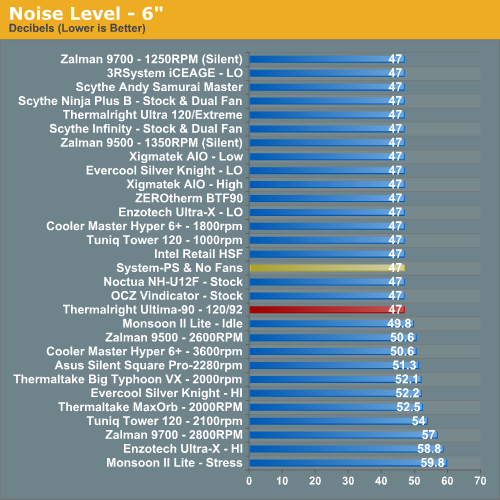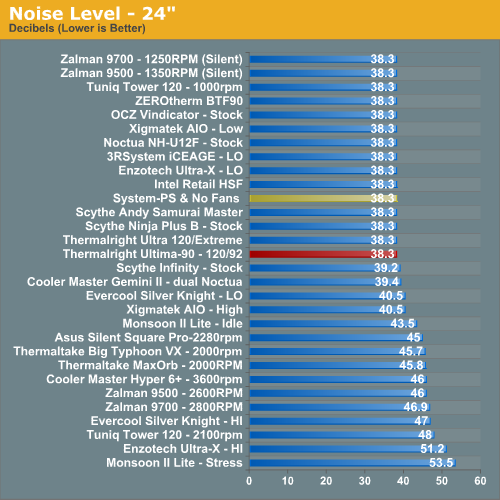Thermalright Ultima-90: Small Wonder?
by Wesley Fink on August 20, 2007 2:00 AM EST- Posted in
- Cases/Cooling/PSUs
Noise
For many enthusiasts upgrading cooling the goal is maximum stable overclock, and they will live with the inconvenience of a louder system. For other users silence is the most important factor, and these users will forgo maximum overclocking if that increases system noise levels.
There are very few power supplies that do not have a fan. While Zalman and a few others do make expensive fanless power supplies, we have not seen a fanless unit larger than 500W, or one that would be used for seriously overclocking a system. With that in mind the noise level of the system with all fans turned off except the PSU was measured. The power supply used for the cooling test bed is the OCZ PowerStream 520, which is one of the quieter high performance power supplies.
We have also measured the Corsair 620W and Mushkin 650W power supplies which are reported to be quieter than the OCZ. Both the Corsair and Mushkin are indeed quieter at idle or start up speed. However, as soon as load testing begins and the PSU fan speed kicks up the measured noise level is almost exactly the same as the OCZ PowerStream 520W.
We are currently in the process of reevaluating our cooler test bed and planning some updates. The new configuration will include a "quieter" power supply with variable speed and noise levels. We will also update to a P35 or X38 chipset motherboard with all passive cooling to the chipset. Changes to the test bed will appear as part of a future roundup with the motherboard, PSU, and CPU all upgraded to more current configurations. We are also investigating a change to a quad-core processor as a further challenge to CPU cooling.
The noise level of the power supply is 38.3 dB from 24" (61cm) and 47 dB from 6" (152mm). The measured noise level of the test room is 36.4 dB, which is a relatively quiet room with a noise floor slightly below that of the OCZ PowerStream 520 PSU.
Noise levels were measured with the S-FLEX 120mm and Panaflo 92mm fans under idle and stress operating conditions. Both measurements were taken at 6" and 24" above the cooling fan on an open case side. Results are then compared to the other coolers/fans tested in this category. Measured noise levels in this chart should be considered worst case. Measurements are taken with an open side of a mid tower case 6" and 24" from the HSF. Real world would be a completely closed case with a further reduction in noise.


In all cases, under both idle and stress conditions, with the S-FLEX and Panaflo fans, the Thermalright Ultima-90 was at noise levels below our system noise floor. This is not surprising since the fans were chosen for the combination of moderately high output combined with low noise. Since a fan is not provided with the Ultima-90, you can choose the fan based on your requirements for the system - either ultra low-noise or high output for maximum cooling, or a fan which balances high output with low noise. There are a number of great fans on the market today that prove you can have both quiet and performance if you shop carefully. Fan prices vary widely as the Panaflo H1A BX is just over $6 on the web, while the S-FLEX is around $20. You can also find better prices in 120mm fans that meet your requirements if you compare specs and review results and shop carefully.
For many enthusiasts upgrading cooling the goal is maximum stable overclock, and they will live with the inconvenience of a louder system. For other users silence is the most important factor, and these users will forgo maximum overclocking if that increases system noise levels.
There are very few power supplies that do not have a fan. While Zalman and a few others do make expensive fanless power supplies, we have not seen a fanless unit larger than 500W, or one that would be used for seriously overclocking a system. With that in mind the noise level of the system with all fans turned off except the PSU was measured. The power supply used for the cooling test bed is the OCZ PowerStream 520, which is one of the quieter high performance power supplies.
We have also measured the Corsair 620W and Mushkin 650W power supplies which are reported to be quieter than the OCZ. Both the Corsair and Mushkin are indeed quieter at idle or start up speed. However, as soon as load testing begins and the PSU fan speed kicks up the measured noise level is almost exactly the same as the OCZ PowerStream 520W.
We are currently in the process of reevaluating our cooler test bed and planning some updates. The new configuration will include a "quieter" power supply with variable speed and noise levels. We will also update to a P35 or X38 chipset motherboard with all passive cooling to the chipset. Changes to the test bed will appear as part of a future roundup with the motherboard, PSU, and CPU all upgraded to more current configurations. We are also investigating a change to a quad-core processor as a further challenge to CPU cooling.
The noise level of the power supply is 38.3 dB from 24" (61cm) and 47 dB from 6" (152mm). The measured noise level of the test room is 36.4 dB, which is a relatively quiet room with a noise floor slightly below that of the OCZ PowerStream 520 PSU.
Noise levels were measured with the S-FLEX 120mm and Panaflo 92mm fans under idle and stress operating conditions. Both measurements were taken at 6" and 24" above the cooling fan on an open case side. Results are then compared to the other coolers/fans tested in this category. Measured noise levels in this chart should be considered worst case. Measurements are taken with an open side of a mid tower case 6" and 24" from the HSF. Real world would be a completely closed case with a further reduction in noise.


In all cases, under both idle and stress conditions, with the S-FLEX and Panaflo fans, the Thermalright Ultima-90 was at noise levels below our system noise floor. This is not surprising since the fans were chosen for the combination of moderately high output combined with low noise. Since a fan is not provided with the Ultima-90, you can choose the fan based on your requirements for the system - either ultra low-noise or high output for maximum cooling, or a fan which balances high output with low noise. There are a number of great fans on the market today that prove you can have both quiet and performance if you shop carefully. Fan prices vary widely as the Panaflo H1A BX is just over $6 on the web, while the S-FLEX is around $20. You can also find better prices in 120mm fans that meet your requirements if you compare specs and review results and shop carefully.










38 Comments
View All Comments
andereandre - Tuesday, August 21, 2007 - link
In these articles the Intel HSF is always classified as having the same noise level as the best coolers (and system-ps & no fans).
I have a X2 4600 however, and I hear the AM2 stock cooler at idle.
Does this mean that de Intel stock cooler is that much better than the AMD one, or is it just the measurement?
That is of real interest to me as I am looking to replace my cooler to make my pc more silent, not to oc it.
Wesley Fink - Tuesday, August 21, 2007 - link
Early Intel 775 stock coolers were very noisy, but for the last year or so the Intel stock cooler is very quiet. That is further enhanced by the 4-pin fan connection that varies fan speed based on CPU temp and BIOS settings. Intel also uses a fan that is a standard 25mm thick.While I don't have measurements for you, the AMD fan is noisier to my ears. AMD does use heatpipes, but they also use a very thin fan that has to run higher rpm to move enough air for cooling.
Beenthere - Monday, August 20, 2007 - link
For years Thermalright has delivered best in class performance with all of the products. No reason to expect any difference with the Small Wonder. Thermalright does good engineering and proves out their product instead of rushing some POS out the door as the trick-of-the week product. And with Thermalright you don't get some stupid shitze whisles and bells to sucker the clueless sheep into buying their products.Axbattler - Monday, August 20, 2007 - link
@ Wesley Fink: Can you please confirm that the height of the cooler with a 120mm fan attached is indeed shorter than the Ninja with a 120mm fan attached? I know that the Ninja is 150mm high, whereas the Ultima is 139mm, so I would expect, all things being equal that the Ultima requires less space than the Ninja. But a confirmation would be helpful as I've been looking for a cooler with comparable performance with the Ninja but a few (5-10mm) shorter.Wesley Fink - Monday, August 20, 2007 - link
1600 RPM is correct, and the chart is corrected.As for the Scythe Infinity, we can only report what we find, and others report what they find. You might compare test beds and methods for an explanation. The Infinity is deservedly loved by those whose primary goal is silence. That means the fan is relatively low output compared to coolers designed for overclocking as the primary goal.
We did find the Infinity reached 3.90 GHz at the top tier of our performance results when two fans were used in a push-pull arrangement. That is also included in our Scaling charts. As reported in our Infinity review the cooler can mount up to four fans.
jackylman - Monday, August 20, 2007 - link
In the first sentence of the last paragraph on the last page."We asked in the beginning of this review if the smaller and lighter Thermalright Ultima-120 might be too compromised...
Wesley Fink - Monday, August 20, 2007 - link
We saved the most obvious for last :) Now corrected.xxxCHAOSxxx - Monday, August 20, 2007 - link
Gents,I have been looking at the cooler market for about 2 or 3 months.. I was torn between the Tuniq 120, thermalright Ultra 120 and the Vigor Monsoon.. however each had a few things that i am a bit leary of. Mainly the weight and size issue. Currently I am running a thermaltake typhoon but am not happy with it. I have to go in every so often and adjust the screws holding it down as they appear to lossen over a short period of time. Based on your review of the thermals, i have just ordered the Ultima 90 and will drop you a line based on my results.
thanks!!
E6600
EVGA 680i
2Gig Memory
EVGA 8800GTX KO w/ ACS3
Thermaltake Armor
Thermaltake Toughpower 800
yacoub - Monday, August 20, 2007 - link
Been looking forward to an Anandtech review of this cooler for about three months now (since the first sneak peak review was seen on another forum). Glad to see this is indeed a pretty badass cooler! =)MercenaryForHire - Monday, August 20, 2007 - link
Something's not quite adding up there ...